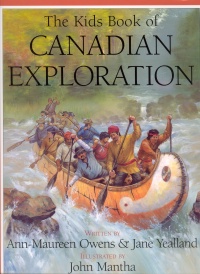| ________________
CM . . .
. Volume XI Number 17 . . . . April 29, 2005
excerpt: Maps were expensive and often jealously guarded. Many skippers of fishing boats to the Grand Banks had to rely on rhyming poems that painted a picture of the coastline with words. These map songs were passed from generation to generation within a family, but very few were written down. One example that was written down in 1750 is "Waldham's Song", which maps 100 km (60 mi.) of Newfoundland's coast in eleven verses: "If you draw near to Fogo Land For thousands of years before the arrival of the Europeans, Native peoples explored and settled Canada. The lure of silks and spices from Asia drove the Europeans to cross the Atlantic in search of a quick route to the Orient. This book provides a general overview of the explorers- from the Vikings to Columbus, Cabot, Cartier and many others- whose contributions resulted, not only in the settlement of Canada, but also in the creation of maps and charts and a better understanding of this land, its coastlines and waters, and even outer space. The authors trace the history of the search for the Northwest Passage, the fur trade that employed thousands of people, the formation of the North West Company and the exploration of the west and the arctic. In addition to information about specific explorers, Owens and Yealland discuss navigational tools, such as quadrants, cross-staffs and astrolabes; ship design and construction, with emphasis on different types of ships, sails and hulls; and the various foods, clothing, shelter and methods of transportation that were critical to wilderness survival. A section on map-making explains the importance of charts, which, unlike maps, showed data about sea coasts, such as shape, water depth and the location of hidden rocks and dangerous shoals. The final chapter is devoted to scientific exploration -- geological and fossil finds, outer space and the underwater environment and its ecosystem -- right up to the present. Though some of the book's 23 chapters focus on specific explorers, the book is fairly general in scope. Boxes containing facts and anecdotes break up the text and add interest. There are plenty of colour illustrations, some of them scenic and others portraits, as well as diagrams and maps of the explorers' voyages across the Atlantic and their journeys across Canada. A table of contents, an index and a timeline are also included. Highly Recommended. Gail Hamilton is a teacher-librarian at Bird's Hill School in East St. Paul, MB.
To comment
on this title or this review, send mail to cm@umanitoba.ca.
Copyright © the Manitoba Library Association. Reproduction for personal
use is permitted only if this copyright notice is maintained. Any
other reproduction is prohibited without permission.
NEXT REVIEW |TABLE OF CONTENTS FOR THIS ISSUE - April 29, 2005. AUTHORS | TITLES | MEDIA REVIEWS | PROFILES | BACK ISSUES | SEARCH | CMARCHIVE | HOME |
